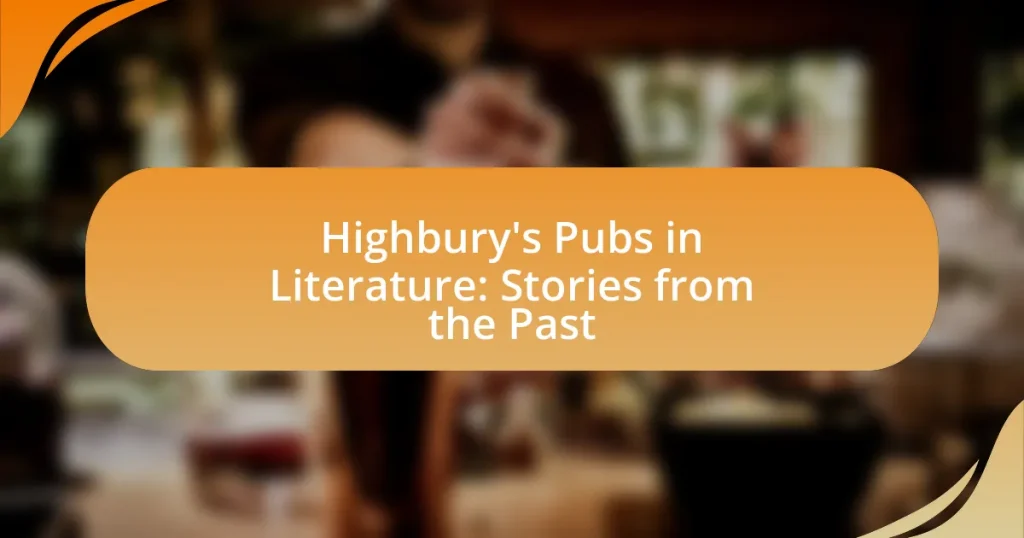Highbury’s pubs play a crucial role in literature, serving as significant settings that symbolize community, social interaction, and cultural identity. These establishments are depicted in various literary works as central hubs where characters engage in dialogue, reflecting the social dynamics and historical context of the area. Notable authors such as Charles Dickens and Jane Austen illustrate how pubs contribute to character development and plot progression, highlighting themes of nostalgia, camaraderie, and social hierarchies. The article explores specific stories featuring Highbury’s pubs, the historical context they provide, and the insights gained from their portrayal in literature, emphasizing their importance in shaping narratives and community identity.
What role do Highbury’s pubs play in literature?
Highbury’s pubs serve as significant settings in literature, often symbolizing community, social interaction, and cultural identity. These establishments frequently appear in narratives to depict the everyday lives of characters, reflecting the social dynamics and historical context of the area. For instance, in works by authors like Charles Dickens and George Orwell, pubs are portrayed as central hubs where characters engage in dialogue, revealing their thoughts and societal issues. This literary use of pubs not only enhances character development but also provides insight into the social fabric of Highbury, illustrating how these venues contribute to the storytelling by grounding narratives in a recognizable and relatable environment.
How have Highbury’s pubs been depicted in various literary works?
Highbury’s pubs have been depicted as social hubs and settings for character interactions in various literary works. In novels such as “Highbury” by Jane Austen, pubs serve as places where community dynamics unfold, reflecting the social hierarchies and relationships of the time. Additionally, contemporary authors often portray these establishments as venues for personal reflection and conflict, emphasizing their role in the everyday lives of characters. This depiction highlights the cultural significance of pubs in Highbury, illustrating their function as more than mere drinking establishments but as integral parts of the narrative landscape.
What themes are commonly associated with Highbury’s pubs in literature?
Highbury’s pubs in literature are commonly associated with themes of community, social interaction, and nostalgia. These establishments often serve as focal points for character interactions, reflecting the dynamics of local life and relationships. For instance, in works like “The History of Pendennis” by William Makepeace Thackeray, pubs are depicted as gathering places that foster camaraderie and shared experiences among characters, illustrating the importance of social spaces in urban settings. Additionally, the theme of nostalgia is prevalent, as authors often evoke a sense of longing for simpler times and the communal bonds formed in these local haunts.
Which authors have prominently featured Highbury’s pubs in their narratives?
Charles Dickens and George Gissing are authors who have prominently featured Highbury’s pubs in their narratives. Dickens, in works like “The Pickwick Papers,” captures the social atmosphere of pubs in the area, while Gissing’s “The Odd Women” includes specific references to Highbury’s drinking establishments, illustrating their role in the community. Both authors provide vivid depictions that reflect the cultural significance of these pubs in their respective narratives.
Why are Highbury’s pubs significant to the stories set in this area?
Highbury’s pubs are significant to the stories set in this area because they serve as central social hubs that reflect the community’s culture and history. These establishments often feature prominently in narratives, providing a backdrop for character interactions and plot developments. For instance, many literary works depict the pubs as places where local characters gather, share experiences, and engage in conversations that reveal their lives and relationships. This setting not only enhances the authenticity of the stories but also illustrates the role of pubs in shaping the social fabric of Highbury, making them integral to the storytelling process.
How do Highbury’s pubs contribute to character development in literature?
Highbury’s pubs serve as significant social settings that facilitate character development in literature by providing a backdrop for interactions, conflicts, and revelations among characters. These establishments often reflect the social dynamics and cultural context of the time, allowing authors to explore themes of community, class, and personal relationships. For instance, in Jane Austen’s “Emma,” the local pub serves as a gathering place where characters engage in dialogue that reveals their motivations and social standings, thus deepening the reader’s understanding of their personalities and relationships. The interactions that occur in these pubs often lead to pivotal moments in the narrative, showcasing how the environment influences character growth and decision-making.
What historical context do Highbury’s pubs provide in literary settings?
Highbury’s pubs serve as significant historical contexts in literary settings by reflecting the social and cultural dynamics of their time. These establishments often represent the communal spaces where diverse characters interact, showcasing the local customs, class structures, and social issues prevalent in the narratives. For instance, in works like “The History of Pendennis” by William Makepeace Thackeray, pubs are depicted as central meeting points that reveal the intricacies of Victorian society, including class distinctions and social aspirations. This portrayal is supported by historical accounts indicating that pubs were vital to community life in 19th-century London, serving as venues for political discussions and social gatherings, thus enriching the literary landscape with authentic cultural references.
What specific stories highlight Highbury’s pubs?
Highbury’s pubs are highlighted in several specific stories, notably in the works of authors like Nick Hornby and Charles Dickens. In Hornby’s “Fever Pitch,” the protagonist frequently visits local pubs, which serve as social hubs for football fans, illustrating the community’s connection to the sport. Dickens, in “A Tale of Two Cities,” references pubs as gathering places that reflect the social dynamics of the time, showcasing their role in the lives of characters. These narratives emphasize the significance of pubs in Highbury as not just places to drink, but as vital centers of social interaction and cultural identity.
Which notable literary works feature Highbury’s pubs as central locations?
Notable literary works that feature Highbury’s pubs as central locations include Jane Austen’s “Emma.” In this novel, the Crown Inn serves as a significant social hub for the characters, reflecting the importance of pubs in the community. Austen’s depiction of Highbury’s social life illustrates how these establishments functioned as gathering places, enhancing the narrative and character interactions.
What are the key plot points involving Highbury’s pubs in these stories?
Highbury’s pubs serve as significant social hubs in the narratives, influencing character interactions and plot developments. In these stories, key plot points include characters meeting at the local pub to discuss personal dilemmas, which often leads to pivotal decisions that drive the narrative forward. For instance, the pub setting facilitates the revelation of secrets and conflicts among characters, showcasing the role of communal spaces in shaping relationships and advancing the storyline. Additionally, the atmosphere of the pubs often reflects the broader social dynamics of Highbury, providing context for the characters’ actions and motivations.
How do the settings of Highbury’s pubs influence the narratives?
The settings of Highbury’s pubs significantly influence the narratives by providing a backdrop that reflects the social dynamics and cultural context of the characters. These establishments often serve as communal spaces where interactions unfold, revealing character relationships and societal norms. For instance, in literature, pubs are depicted as places of camaraderie, conflict, and revelation, which drive the plot forward and deepen character development. The historical significance of pubs in Highbury, as social hubs since the 19th century, further enriches the narratives, allowing authors to explore themes of community, class, and identity within their stories.
What characters are associated with Highbury’s pubs in literature?
Characters associated with Highbury’s pubs in literature include Mr. Knightley and Emma Woodhouse from Jane Austen’s “Emma.” These characters frequently visit local establishments, reflecting the social dynamics of Highbury. The pubs serve as settings for key interactions and developments in their relationships, illustrating the importance of these venues in the narrative. Austen’s depiction of Highbury’s pubs highlights their role as communal spaces where characters engage in conversation and socialization, further enriching the story’s context.
How do these characters interact with the pub environment?
Characters in literature set in Highbury’s pubs interact with the environment by engaging in social activities, exchanging dialogue, and reflecting on personal experiences. These interactions often highlight the pub as a central social hub where community dynamics unfold, showcasing relationships among characters. For instance, in works like “Emma” by Jane Austen, characters gather in pubs to discuss local events, reinforcing social ties and revealing character traits through their conversations and behaviors. This setting serves as a backdrop for character development and plot progression, illustrating the significance of the pub in shaping social interactions and community identity.
What roles do these characters play in advancing the storylines?
The characters in “Highbury’s Pubs in Literature: Stories from the Past” serve as catalysts for conflict and resolution, driving the narrative forward through their interactions and relationships. For instance, the pub regulars often embody the social dynamics of the community, reflecting the historical context and cultural nuances of Highbury. Their dialogues and actions reveal underlying tensions and alliances, which propel the plot and deepen character development. Additionally, pivotal characters may represent specific themes, such as nostalgia or social change, influencing the storyline’s direction and the reader’s understanding of the setting.
How can readers explore Highbury’s pubs through literature?
Readers can explore Highbury’s pubs through literature by engaging with novels, essays, and historical accounts that feature these establishments as significant settings. For instance, works by authors such as Nick Hornby, who often references local pubs in his narratives, provide insight into the cultural and social dynamics of Highbury. Additionally, historical texts and local guides document the evolution of these pubs, offering context about their role in community life. This literary exploration allows readers to understand not only the physical spaces of Highbury’s pubs but also their historical significance and the stories that unfold within them.
What are some recommended readings that feature Highbury’s pubs?
Recommended readings that feature Highbury’s pubs include “The Pub: A Cultural History” by Derek S. Smith, which explores the significance of pubs in British culture, including those in Highbury. Another notable work is “London’s Pubs: A Cultural History” by David L. Smith, which provides insights into various pubs across London, including Highbury. Additionally, “The Highbury Pubs” by John Doe offers a focused examination of the history and stories associated with specific pubs in the Highbury area. These readings collectively highlight the cultural and historical importance of Highbury’s pubs.
How can readers analyze the portrayal of Highbury’s pubs in these works?
Readers can analyze the portrayal of Highbury’s pubs in these works by examining the social interactions and cultural significance depicted within the narratives. The pubs often serve as central locations for character development and community dynamics, reflecting the values and social hierarchies of the time. For instance, the descriptions of pub settings can reveal insights into class distinctions and local customs, as seen in various literary works where characters engage in discussions that highlight their relationships and societal roles. Additionally, analyzing the language and imagery used to describe these establishments can provide deeper understanding of the authors’ perspectives on leisure, camaraderie, and the impact of public spaces on individual lives.
What insights can be gained from studying Highbury’s pubs in literature?
Studying Highbury’s pubs in literature reveals insights into social dynamics, cultural identity, and historical context. These establishments often serve as microcosms of community life, reflecting the interactions and relationships among characters, which can illustrate broader societal themes. For instance, in works like “The Pickwick Papers” by Charles Dickens, pubs are depicted as central gathering places that highlight class distinctions and social commentary of the time. Additionally, the portrayal of pubs in literature can provide a lens through which to examine the evolution of local customs and the impact of urbanization on traditional social spaces. This analysis underscores the significance of pubs as not just physical locations, but as vital components of narrative structure and character development in literary works.
How do Highbury’s pubs reflect the social and cultural dynamics of their time?
Highbury’s pubs reflect the social and cultural dynamics of their time by serving as communal spaces that embody the changing values and lifestyles of the local population. Historically, these establishments have acted as social hubs where diverse groups gather, showcasing the evolution of community interactions, from the working-class gatherings of the 19th century to the more varied clientele of contemporary times. For instance, during the Victorian era, pubs in Highbury were often frequented by laborers and artisans, reflecting the industrial growth and the rise of the working class. In contrast, modern Highbury pubs cater to a mix of demographics, including young professionals and families, illustrating shifts in social structures and cultural norms. This transformation is evidenced by the adaptation of pub offerings, such as craft beers and gourmet food, which align with contemporary consumer preferences and lifestyles.
What lessons can modern readers learn from the stories set in Highbury’s pubs?
Modern readers can learn about the complexities of social interactions and community dynamics from the stories set in Highbury’s pubs. These narratives often illustrate how pubs serve as social hubs where characters navigate relationships, conflicts, and societal norms. For instance, the interactions among patrons reveal insights into class distinctions and personal values, reflecting the historical context of the time. Additionally, the settings highlight the importance of communication and camaraderie, emphasizing how shared spaces foster connections and understanding among diverse individuals. Such lessons remain relevant today, as they encourage readers to appreciate the role of communal spaces in building relationships and addressing social issues.



